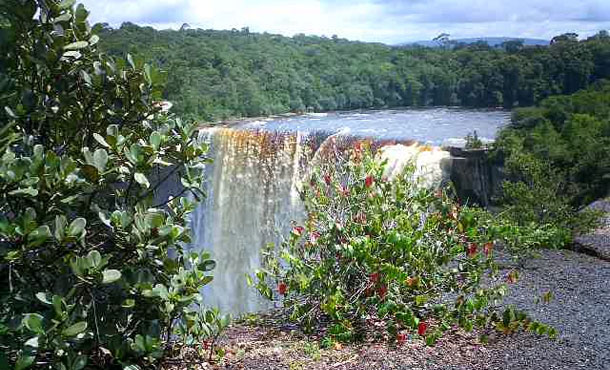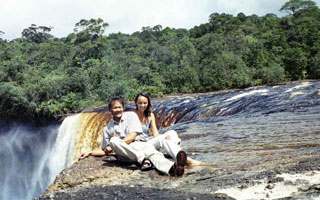The Daily Telegraph - Storybook South America
August 1, 2006
As a child, Michelle Jana Chan heard bedtime tales from her father of the pumas and piranhas of Guyana. The she got the chance to return with him to the land of his birth...

'Now, the anaconda is the world's biggest snake," my dad would tell me, "and this one was the longest and fattest anyone had ever seen in Guyana. I twisted him around, tying him in knots, squeezing the life out of him..."
This is the Guyana of my bedtime stories and occasionally my nightmares. Before I went to sleep, my father would tell me tales about his homeland: how the harpy eagle could carry off children in its talons; how the piranha would shred the flesh from your bones; how the puma would pad into your bedroom, taking you off into the darkness of the jungle.
I would hear also of places called Diamond, Adventure and Roraima, and all-day journeys down mighty rivers called Essequibo, Demerara and Mazaruni. This is where Sir Walter Raleigh searched for the alleged city of gold called El Dorado and Sir Arthur Conan Doyle set his fantastical "Lost World".
Although I had travelled widely, I had never been to the land of my father. "Guyana?" strangers would say to me. "Africa - right?" It always puzzled me why the only former British colony in the continent of South America was so off the map for the English.
So I decided to take my dad - who hadn't been back since 1979 - so he could prove to me he could wrestle an anaconda with his bare hands.
We landed in the capital, Georgetown, a dilapidated city of plantation-style houses and streets lined with flamboyant trees and frangipani. My father was seeing it all differently this time round. "I didn't appreciate the architecture while I lived here, so I must have changed," he said. The city is built with native hardwoods, and, although several large fires have destroyed huge areas in the past century, Georgetown still has an antiquated feel about it.
The first day we drove to Suddie, where my father was born, a muddy riverbank town in the old plantation estates. To get there, we crossed two rivers: the first, the Demerara, over the longest floating-bridge in the world and the second, the 20-mile-wide mouth of the Essequibo, by speedboat. In my dad's youth, the crossings were made by infrequent ferries, which wove in and out of estuary islands the size of Barbados. "We used to take a whole day to get here," he explained. We were there and back in an afternoon.
The country has certainly prospered but Suddie hasn't changed a great deal since he was born in the 1940s - especially at the hospital. The open-air waiting room was full of men on crutches and mothers swatting flies away from their newborns. A sign on the wall said: "Speak quietly. Quiet speech is a mark of refinement."
Back in Georgetown, we went searching for the haunts of my father's youth. We found the back garden where he fired at an iguana with his bow and arrow, and traumatised himself by hitting it. We saw the field where he nearly got trampled by stampeding cows. We walked past the house where he had lived with his grandmother, and from where they had to flee during street riots.
There was a hint of melancholy in our discoveries. Most of his old homes had vanished: some replaced with concrete offices, others torn down to leave a plot of scrub; but a few were still there, barely upright and in need of a whitewash. It was all rather wistful and we resolved to find some fresh, vivid experiences. We fled the city southbound towards the forested interior, which was new territory for us both, and discovered a wilderness teeming with life.
I saw animals I had never even heard of, including a family of capybara, the world's largest rodent, drinking at dusk on the banks of the Rupununi; the black caiman, South America's bigger answer to the alligator; the svelte ocelot, which we found dead by the side of the road; and the peculiar matamata turtle, with its flattened craggy head extending a foot out of its knobbly shell.
Guyana is one of the least explored countries in South America. I met only a handful of non-natives: missionaries, journalists, NGO workers and a couple of birdwatchers.
It isn't easy getting around the interior via a mixture of muddy rivers and brick-red laterite roads, which can morph into an airstrip by propping up a signpost giving warning of LANDINGS. There is little traffic: one vehicle every few hours, which is usually a mud-splattered Bedford truck loaded with miners or fuel.
Once, as we swerved around potholes and puddles in the pristine rainforest of Guiana Shield, we saw a Land Rover coming towards us. In line with local ways, we slowed down and left passing room. Looking across inquisitively, my dad cried out: "That's my cousin!" Our driver braked, blowing his horn. My dad jumped out of the car and the two of them - cousin Gordon and my dad, born on the same day, March 23, 1944 - saw each other for the first time in 47 years.

"You haven't changed a bit," my dad said.
"Neither have you," Gordon replied.
I looked on sceptically, but was also amazed to discover I had cousins tucked away in the heart of the rainforest. This was just one of many reunions on our trip. Among the multicultural population of Indian, Black, Amerindian, Portuguese and Chinese, I found someone of every race connected to me. Our tour companions, Paul and Sylvia, birdwatchers from Cambridge, told me: "We're beginning to think you're related to everyone here."
It did seem that way as we travelled the length of the country, from the coastline belt of rice fields and sugar plantations to the rainforest, through the foothills of the Pakaraima Mountains and into the southern savannah where cowboys herd cattle. Almost every cow carries a white egret, which devours insects stirred up by shuffling hooves.
We decided to stop at the million-acre rainforest reserve called Iwokrama. Gabriel, my guide, told me it rains twice here: "First when the skies open and then when the trees rain." The broad leaves catch the rainwater, 100 feet up, and release drops for an hour after the rainfall has stopped. Which means, by the time the second rain finishes, the first rain begins again, and you never dry out. The glossy green leaves shine and the glistening cobwebs are so thick they hang like white cotton hammocks.
We once managed to escape the second rain atop the Iwokrama Canopy Walkway. Here we teetered across suspension bridges a hundred feet above the forest floor, stopping at observation decks encircling giant cedars to see beyond the treetops towards families of red howler monkeys, blue-headed parrots and white-throated toucans.
We continued our journey along what we nicknamed Jaguar Alley, where two out of three tourists report sightings, but we were in the unlucky third. From here, the rainforest breaks up into scrub, fanning out into wide-open savannah with a smattering of Amerindian villages. We stayed in Surama, inhabited by Macushi Indians, where we met balata bleeders, who collect latex from balata trees; trappers, armed with bows-and-arrows; and "pork-knockers", the local name for gold prospectors.
Conversation dwelt on their latest viper bite and how many times they had had malaria. One guide, Seego, mentioned the anaconda, which he said would "wrap you, mash you and swallow you". I looked across at my dad in wonder.
A few hours up the Rupununi River, we stopped at Karanambu Lodge to meet Diane McTurk, who is renowned for her work with orphaned giant river otters. I joined her for a swim in the muddy Rupununi and felt piranha fish nibble my calves. "Keep moving," she told me. We never did see anaconda - much to my dad's relief, I am sure - but we did spot black caiman, which Diane assured me only hunt at night.
The finale was Kaieteur Falls, 750ft high, which is nearly five times the height of Niagara. In the 1930s, Evelyn Waugh called it "one of the finest, most inaccessible, and least advertised natural wonders of the world". Its colossal power is hypnotic and exhilarating. There are no safety rails, none of the trappings of mass tourism, so you feel as though you're the first person to stumble upon it.
That's the hallmark of a visit to Guyana. I felt like a pioneer, fumbling my way through virgin rainforest. We stood on the very edge of the precipice at Kaieteur, flirting with our fear. In the 25 years since my dad had been here, this was one thing that hadn't changed at all.




